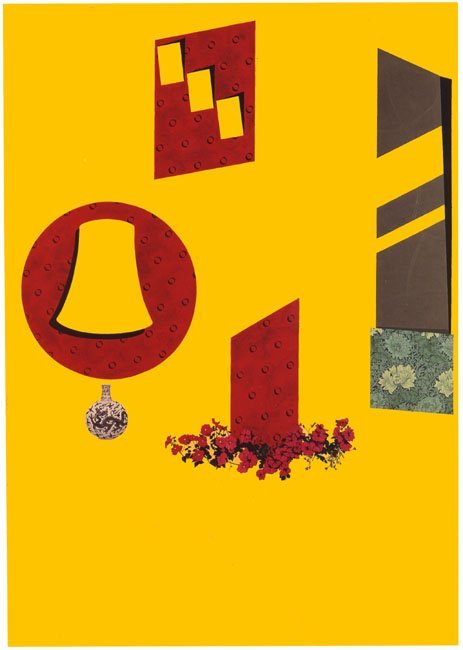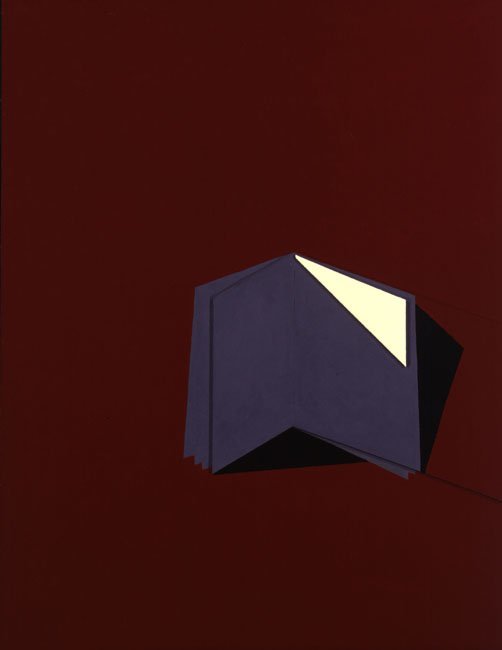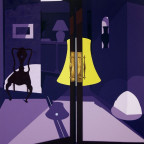Biography
“I don’t see how you can avoid any place suggesting a human presence”
Waddington Galleries presents an exhibition of twenty paintings and nine previously un-exhibited studies for paintings by Patrick Caulfield.
The earliest work in the exhibition is ‘Landscape with Birds’, 1963, painted in black and white decorator’s gloss on hardboard. Depicting birds ascending in half-light it demonstrates the deliberate application of outline and shadow, of silhouetted forms and frame-within-frame composition that would become important pictorial elements in Caulfield’s subsequent work. Caulfield studied at the Royal College of Art between 1960 and 1963, a year behind Hockney and Kitaj. During this time he twice visited Crete, purchasing crude postcards of Minoan Frescoes that “emphasized the bright colours and sharp outlines.” This influence can clearly be seen in ‘Still Life on a Table’, 1964, the black outline separating and intensifying the blues and greens of the painting. In ‘Bistro’, 1970 the painting is pared down further still with the space and content described only by black contour lines against one strong background colour.
All of the nine studies in the exhibition date from between 1971 and 1974. By this time Caulfield had begun to paint on canvas, hardboard having a restrictive maximum width of only 48 inches. Through the accompanying study we can see how one of the exhibition’s largest paintings ‘Springtime: Face a la Mer’, 1974, for example, was initially planned. The drawing has been squared, and vertically indexed by numbers and horizontally by letters. Using felt tip this would have been transferred into its final scale on a similarly squared-up piece of polythene that could then be overlaid and transferred onto canvas. ‘Springtime: Face a la Mer’ shows how Caulfield’s compositions are as much an arrangement of staged props as real social settings; the image of the building was taken from a book of Mediterranean villas and the tree in the foreground drawn directly from outside his London studio.
By the early 1980s Caulfield had abandoned what had become his signature black outline and started to paint without having a finalised idea of how the painting would look. With emotive titles such as ‘Reception’, 1988, and ‘The Register’, 1993, the large works of this period contain objects shaped from light and embellished by shadows, mixed with photorealist elements that float on flat planes of colour. ‘Room’, 1995, and ‘Fruit Display’, 1996, both return to a square format. All suggest the quiet corner spaces of our psyche and comprise of a yellow tungsten light similar to the tone that infused the paintings of Edward Hopper, a painter Caulfield greatly admired.
Five small works from the 1990s show Caulfield consistently adding texture or collage into his painting; Artex-like impasto, paint directly applied from the tube, or in ‘Corner Lamp’, ‘Tall Bottle’ and ‘Menu’, all from 1998, the visual challenge of inventing different forms from the same starting block of an upturned cut out “V”.
-
 Patrick Caulfield, Reception, 1988
acrylic on canvas
120 x 81 in / 304.8 x 205.7 cm
%3Cdiv%20class%3D%22artist%22%3E%3Cspan%20class%3D%22artist%22%3E%3Cstrong%3EPatrick%20Caulfield%3C/strong%3E%3C/span%3E%3C/div%3E%0D%3Cdiv%20class%3D%22title%22%3E%3Cem%3EReception%3C/em%3E%2C%201988%3C/div%3E%0D%3Cdiv%20class%3D%22medium%22%3Eacrylic%20on%20canvas%3C/div%3E%0D%3Cdiv%20class%3D%22dimensions%22%3E120%20x%2081%20in%20/%20304.8%20x%20205.7%20cm%3C/div%3E
Patrick Caulfield, Reception, 1988
acrylic on canvas
120 x 81 in / 304.8 x 205.7 cm
%3Cdiv%20class%3D%22artist%22%3E%3Cspan%20class%3D%22artist%22%3E%3Cstrong%3EPatrick%20Caulfield%3C/strong%3E%3C/span%3E%3C/div%3E%0D%3Cdiv%20class%3D%22title%22%3E%3Cem%3EReception%3C/em%3E%2C%201988%3C/div%3E%0D%3Cdiv%20class%3D%22medium%22%3Eacrylic%20on%20canvas%3C/div%3E%0D%3Cdiv%20class%3D%22dimensions%22%3E120%20x%2081%20in%20/%20304.8%20x%20205.7%20cm%3C/div%3E -
 Patrick Caulfield, Lounge, 1989
acrylic on canvas
114 x 81 in / 289.5 x 205.7 cm
%3Cdiv%20class%3D%22artist%22%3E%3Cspan%20class%3D%22artist%22%3E%3Cstrong%3EPatrick%20Caulfield%3C/strong%3E%3C/span%3E%3C/div%3E%0D%3Cdiv%20class%3D%22title%22%3E%3Cem%3ELounge%3C/em%3E%2C%201989%3C/div%3E%0D%3Cdiv%20class%3D%22medium%22%3Eacrylic%20on%20canvas%3C/div%3E%0D%3Cdiv%20class%3D%22dimensions%22%3E114%20x%2081%20in%20/%20289.5%20x%20205.7%20cm%3C/div%3E
Patrick Caulfield, Lounge, 1989
acrylic on canvas
114 x 81 in / 289.5 x 205.7 cm
%3Cdiv%20class%3D%22artist%22%3E%3Cspan%20class%3D%22artist%22%3E%3Cstrong%3EPatrick%20Caulfield%3C/strong%3E%3C/span%3E%3C/div%3E%0D%3Cdiv%20class%3D%22title%22%3E%3Cem%3ELounge%3C/em%3E%2C%201989%3C/div%3E%0D%3Cdiv%20class%3D%22medium%22%3Eacrylic%20on%20canvas%3C/div%3E%0D%3Cdiv%20class%3D%22dimensions%22%3E114%20x%2081%20in%20/%20289.5%20x%20205.7%20cm%3C/div%3E -
 Patrick Caulfield, Night Pipe, 1992
acrylic on canvas
24 x 30 in / 60.1 x 76.2 cm
Patrick Caulfield, Night Pipe, 1992
acrylic on canvas
24 x 30 in / 60.1 x 76.2 cm
-
 Patrick Caulfield, Study for 'In My Room', c.1974
pencil and pen on board
21 1/2 x 31 1/2 in / 54.6 x 80 cm
%3Cdiv%20class%3D%22artist%22%3E%3Cspan%20class%3D%22artist%22%3E%3Cstrong%3EPatrick%20Caulfield%3C/strong%3E%3C/span%3E%3C/div%3E%0D%3Cdiv%20class%3D%22title%22%3E%3Cem%3EStudy%20for%20%27In%20My%20Room%27%3C/em%3E%2C%20c.1974%3C/div%3E%0D%3Cdiv%20class%3D%22medium%22%3Epencil%20and%20pen%20on%20board%3C/div%3E%0D%3Cdiv%20class%3D%22dimensions%22%3E21%201/2%20x%2031%201/2%20in%20/%2054.6%20x%2080%20cm%3C/div%3E
Patrick Caulfield, Study for 'In My Room', c.1974
pencil and pen on board
21 1/2 x 31 1/2 in / 54.6 x 80 cm
%3Cdiv%20class%3D%22artist%22%3E%3Cspan%20class%3D%22artist%22%3E%3Cstrong%3EPatrick%20Caulfield%3C/strong%3E%3C/span%3E%3C/div%3E%0D%3Cdiv%20class%3D%22title%22%3E%3Cem%3EStudy%20for%20%27In%20My%20Room%27%3C/em%3E%2C%20c.1974%3C/div%3E%0D%3Cdiv%20class%3D%22medium%22%3Epencil%20and%20pen%20on%20board%3C/div%3E%0D%3Cdiv%20class%3D%22dimensions%22%3E21%201/2%20x%2031%201/2%20in%20/%2054.6%20x%2080%20cm%3C/div%3E -
 Patrick Caulfield, Study for 'Paradise Bar', c.1974
pencil and pen on board
21 1/2 x 31 1/2 in / 54.6 x 80 cm
%3Cdiv%20class%3D%22artist%22%3E%3Cstrong%3EPatrick%20Caulfield%3C/strong%3E%3C/div%3E%0D%3Cdiv%20class%3D%22title%22%3E%3Cem%3EStudy%20for%20%27Paradise%20Bar%27%3C/em%3E%2C%20c.1974%3C/div%3E%0D%3Cdiv%20class%3D%22medium%22%3Epencil%20and%20pen%20on%20board%3C/div%3E%0D%3Cdiv%20class%3D%22dimensions%22%3E21%201/2%20x%2031%201/2%20in%20/%2054.6%20x%2080%20cm%3C/div%3E
Patrick Caulfield, Study for 'Paradise Bar', c.1974
pencil and pen on board
21 1/2 x 31 1/2 in / 54.6 x 80 cm
%3Cdiv%20class%3D%22artist%22%3E%3Cstrong%3EPatrick%20Caulfield%3C/strong%3E%3C/div%3E%0D%3Cdiv%20class%3D%22title%22%3E%3Cem%3EStudy%20for%20%27Paradise%20Bar%27%3C/em%3E%2C%20c.1974%3C/div%3E%0D%3Cdiv%20class%3D%22medium%22%3Epencil%20and%20pen%20on%20board%3C/div%3E%0D%3Cdiv%20class%3D%22dimensions%22%3E21%201/2%20x%2031%201/2%20in%20/%2054.6%20x%2080%20cm%3C/div%3E -
 Patrick Caulfield, Study for 'The Mysterious Suspicion - After Magritte', c.1974
pencil and pen on paper
20 x 18 1/4 in / 50.8 x 46.4 cm
%3Cdiv%20class%3D%22artist%22%3E%3Cstrong%3EPatrick%20Caulfield%3C/strong%3E%3C/div%3E%0D%3Cdiv%20class%3D%22title%22%3E%3Cem%3EStudy%20for%20%27The%20Mysterious%20Suspicion%20-%20After%20Magritte%27%3C/em%3E%2C%20c.1974%3C/div%3E%0D%3Cdiv%20class%3D%22medium%22%3Epencil%20and%20pen%20on%20paper%3C/div%3E%0D%3Cdiv%20class%3D%22dimensions%22%3E20%20x%2018%201/4%20in%20/%2050.8%20x%2046.4%20cm%3C/div%3E
Patrick Caulfield, Study for 'The Mysterious Suspicion - After Magritte', c.1974
pencil and pen on paper
20 x 18 1/4 in / 50.8 x 46.4 cm
%3Cdiv%20class%3D%22artist%22%3E%3Cstrong%3EPatrick%20Caulfield%3C/strong%3E%3C/div%3E%0D%3Cdiv%20class%3D%22title%22%3E%3Cem%3EStudy%20for%20%27The%20Mysterious%20Suspicion%20-%20After%20Magritte%27%3C/em%3E%2C%20c.1974%3C/div%3E%0D%3Cdiv%20class%3D%22medium%22%3Epencil%20and%20pen%20on%20paper%3C/div%3E%0D%3Cdiv%20class%3D%22dimensions%22%3E20%20x%2018%201/4%20in%20/%2050.8%20x%2046.4%20cm%3C/div%3E -
 Patrick Caulfield, Study for 'Tandoori Restaurant', c.1971
pencil and pen on paper
22 x 30 in / 55.9 x 76.2 cm
%3Cdiv%20class%3D%22artist%22%3E%3Cspan%20class%3D%22artist%22%3E%3Cstrong%3EPatrick%20Caulfield%3C/strong%3E%3C/span%3E%3C/div%3E%0D%3Cdiv%20class%3D%22title%22%3E%3Cem%3EStudy%20for%20%27Tandoori%20Restaurant%27%3C/em%3E%2C%20c.1971%3C/div%3E%0D%3Cdiv%20class%3D%22medium%22%3Epencil%20and%20pen%20on%20paper%3C/div%3E%0D%3Cdiv%20class%3D%22dimensions%22%3E22%20x%2030%20in%20/%2055.9%20x%2076.2%20cm%3C/div%3E
Patrick Caulfield, Study for 'Tandoori Restaurant', c.1971
pencil and pen on paper
22 x 30 in / 55.9 x 76.2 cm
%3Cdiv%20class%3D%22artist%22%3E%3Cspan%20class%3D%22artist%22%3E%3Cstrong%3EPatrick%20Caulfield%3C/strong%3E%3C/span%3E%3C/div%3E%0D%3Cdiv%20class%3D%22title%22%3E%3Cem%3EStudy%20for%20%27Tandoori%20Restaurant%27%3C/em%3E%2C%20c.1971%3C/div%3E%0D%3Cdiv%20class%3D%22medium%22%3Epencil%20and%20pen%20on%20paper%3C/div%3E%0D%3Cdiv%20class%3D%22dimensions%22%3E22%20x%2030%20in%20/%2055.9%20x%2076.2%20cm%3C/div%3E -
 Patrick Caulfield, Study for 'Inner Office', c.1973
pencil and pen on board
20 x 13 3/4 in / 50.8 x 34.9 cm
%3Cdiv%20class%3D%22artist%22%3E%3Cstrong%3EPatrick%20Caulfield%3C/strong%3E%3C/div%3E%0D%3Cdiv%20class%3D%22title%22%3E%3Cem%3EStudy%20for%20%27Inner%20Office%27%3C/em%3E%2C%20c.1973%3C/div%3E%0D%3Cdiv%20class%3D%22medium%22%3Epencil%20and%20pen%20on%20board%3C/div%3E%0D%3Cdiv%20class%3D%22dimensions%22%3E20%20x%2013%203/4%20in%20/%2050.8%20x%2034.9%20cm%3C/div%3E
Patrick Caulfield, Study for 'Inner Office', c.1973
pencil and pen on board
20 x 13 3/4 in / 50.8 x 34.9 cm
%3Cdiv%20class%3D%22artist%22%3E%3Cstrong%3EPatrick%20Caulfield%3C/strong%3E%3C/div%3E%0D%3Cdiv%20class%3D%22title%22%3E%3Cem%3EStudy%20for%20%27Inner%20Office%27%3C/em%3E%2C%20c.1973%3C/div%3E%0D%3Cdiv%20class%3D%22medium%22%3Epencil%20and%20pen%20on%20board%3C/div%3E%0D%3Cdiv%20class%3D%22dimensions%22%3E20%20x%2013%203/4%20in%20/%2050.8%20x%2034.9%20cm%3C/div%3E -
 Patrick Caulfield, Menu, 1998
acrylic on board
26 x 20 1/2 in / 66 x 52.1 cm
%3Cdiv%20class%3D%22artist%22%3E%3Cspan%20class%3D%22artist%22%3E%3Cstrong%3EPatrick%20Caulfield%3C/strong%3E%3C/span%3E%3C/div%3E%0D%3Cdiv%20class%3D%22title%22%3E%3Cem%3EMenu%3C/em%3E%2C%201998%3C/div%3E%0D%3Cdiv%20class%3D%22medium%22%3Eacrylic%20on%20board%3C/div%3E%0D%3Cdiv%20class%3D%22dimensions%22%3E26%20x%2020%201/2%20in%20/%2066%20x%2052.1%20cm%3C/div%3E
Patrick Caulfield, Menu, 1998
acrylic on board
26 x 20 1/2 in / 66 x 52.1 cm
%3Cdiv%20class%3D%22artist%22%3E%3Cspan%20class%3D%22artist%22%3E%3Cstrong%3EPatrick%20Caulfield%3C/strong%3E%3C/span%3E%3C/div%3E%0D%3Cdiv%20class%3D%22title%22%3E%3Cem%3EMenu%3C/em%3E%2C%201998%3C/div%3E%0D%3Cdiv%20class%3D%22medium%22%3Eacrylic%20on%20board%3C/div%3E%0D%3Cdiv%20class%3D%22dimensions%22%3E26%20x%2020%201/2%20in%20/%2066%20x%2052.1%20cm%3C/div%3E

















